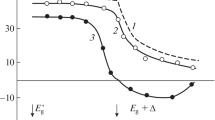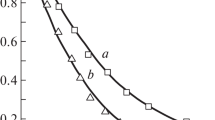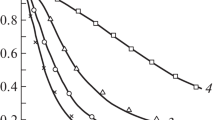The first experiments on optical orientation of free carriers in semiconductors were performed recently [1– 5]. Since holes usually do not become oriented in the valence band, owing to rapid relaxation of their spins [6], most experiments were performed on p-type materials and the oriented carriers were the electrons propelled into the conduction band by circularly polarized light. Thus, only the spins of non-equilibrium carriers were oriented, a phenomenon analogous to the optical orientation of excited gas atoms [7]. However, we have previously observed [3] optical orientation also in n-type material. We show in the present paper that this phenomenon is due to optical orientation of equilibrium electrons, i.e., the orientation is realized in the ground state, in analogy with “optical pumping” of atoms [7].
Similar content being viewed by others
Avoid common mistakes on your manuscript.
The possibility of optical orientation of equilibrium electrons in n-type semiconductors was predicted in the theoretical paper of D’yakonov and Perel’ [8]. This effect is determined by the following: circularly polarized light propels into the conduction band predominantly electrons with one spin direction, but the rate of electron recombination is independent of their spin. Obviously, this should lead to accumulation of oriented electrons in the conduction band. If the spin-relaxation time τs is large compared with the life-time τ of the non-equilibrium electron, then an appreciable fraction of the equilibrium carriers can be transferred to the oriented state. Near the surface, the degree of stationary orientation of the electrons P (P = |(n+ – n–)/(n+ + n–)|, where n± is the number of electrons with different spin orientations) will be determined by the relation [8]
where P0 is the orientation of the electron during the instant of its production by the light (P0 = 0.5 for the Γ8–Γ6 interband transitions [6]), I is the excitation intensity, n0 the equilibrium electron density, and Ls is the diffusion length, determined by the electron diffusion coefficient and by the time τs.
An essential feature of this effect, as seen from (1), is the dependence of the degree of orientation on the excitation intensity. In the region of small orientations (Iτs \( \ll \) n0Ls) the dependence will be approximately linear.
We note that this should not occur when the non-equilibrium carriers are oriented, since their number depends on the light intensity, but the degree of orientation does not depend on the intensity.
Our investigations were performed on n-GaxAll–xAs (\( \lesssim \)1016 cm–3) at 4.2 K. The electrons were oriented by circularly polarized He–Ne laser light, which yielded excitation intensities \( \lesssim \)5 × 1020 quanta/(cm2s). The composition of the crystals (x \( \simeq \) 0.7) was chosen such as to make the width of the forbidden band close to the quantum energy of the exciting light. The degree of electron orientation, as before [3, 4], was determined from the degree of circular polarization of the combination luminescence S (S = |(I+ – I–)/(I+ + I–)|, where I± is the intensity of emission in circularly polarized light with right-hand and left-hand rotation). As shown by D’yakonov and Perel’ [6], for transitions in which shallow, impurities and excitons take place we have S = 0.5P.
Figure 1 shows a typical photoluminescence spectrum of the crystals at 4.2 K. It can be shownFootnote 1 that the bands appearing in the spectrum are due to radiative transitions from the donor to the acceptor (band B) and to recombination of an exciton (free or bound, band A). Figure 2 shows the observed dependence of the degree of polarization of these luminescence bands on the excitation intensity.Footnote 2 We see that these plots are significantly different: the polarization of band A is practically constant (S = 7%), but for band В the polarization varies linearly with the light intensity.
The observed relations can be explained by recognizing that at sufficiently low temperatures practically all the equilibrium electrons are frozen at the donor levels. Under these conditions, only the non-equilibrium carriers take part in the exciton production,Footnote 3 and their degree of orientation does not depend on the excitation intensity. This obviously determines the constancy of the polarization of the exciton line A.
Line В is due to transitions from the donor level. In such transitions, the equilibrium and non-equilibrium electrons on the donors participate to an equal degree, and this should lead, as already mentioned, to accumulation of oriented carriers, i.e., to orientation of the equilibrium electrons. The observed linear dependence of the degree of luminescence polarization on the pump light intensity shows directly that the equilibrium carriers at the impurity levels are indeed oriented in this case.Footnote 4 The slope of curve В in Fig. 2 differs somewhat for different samples, and this may be due, in particular, to differences in n0 (see formula (1)).
Measurements of luminescence polarization in a transverse magnetic field gave the following lifetimes of the oriented spin [2–4]: \( \simeq \)5 × 10–10 s for the exciton (band A), and 1.2 × 10–9 s for the donor (band B). Obviously, this time is determined in either case mainly by the spin-relaxation time. One can thus conclude that the spin relaxation differs for an electron bound at a donor or in an exciton.
The maximum degree of polarization of band В was \( \simeq \)0.03. This corresponds to an orientation of \( \simeq \)6% of all electrons at the donors. From Formula (1) we can estimate the penetration depth Ls of the orientation. In our case Ls \( \simeq \) 1.0 μ, making the estimated electron mobility at 4.2°K of the order of (or lower than) 103 V cm2/s.
The experiments have shown that in n-type semiconductors it is possible to obtain a noticeable orientation of the electrons at the donor levels even at excitation intensities such that the density of the non-equilibrium carriers is smaller than the density of the equilibrium electrons.
Notes
This circumstance will be considered in greater detail in an article by Zh.I. Alferov, D.Z. Garbuzov, et al., Fiz. Tekh. Poluprov. 5 (6) (1971).
The degree of polarization was constant along the contour of each luminescence band (at fixed excitation).
This is evidenced also by the superlinear, near-quadratic dependence of the brightness of band A on the pump-light intensity.
ln some samples, the intensity of line В (IВ) had an essentially nonlinear (sublinear) dependence on the pump intensity (I). The dependence of S on IВ, however, was always linear, for it was precisely the electron recombination rate (and the associated luminescence brightness) which determines the rate of accumulation of the oriented electrons at the donor level.
REFERENCES
G. Lampel, Phys. Rev. Lett. 20, 491 (1968).
R. R. Parsons, Phys. Rev. Lett. 23, 1152 (1969).
A. I. Ekimov and V. I. Safarov, JETP Lett. 12, 198 (1970).
D. Z. Garbuzov, A. I. Ekimov, and V. I. Safarov, JETP Lett. 13, 24 (1971).
B. P. Zakharchenya, V. G. Fleisher, R. D. Dzhioev, Yu. P. Veshchunov, and I. B. Rusanov, JETP Lett. 13, 137 (1971).
M. I. D’yakonov and V. I. Perel’, Sov. Phys. JETP 33, 1053 (1971).
C. Cohen-Tannondji and A. Kastler, Prog. Opt. 5, 33 (1966).
M. I. D’yakonov and V. I. Perel’, JETP Lett. 13, 144 (1971).
ACKNOWLEDGMENTS
We wish to thank V.I. Perel’ and M.I. D’yakonov for useful discussions and E.F. Gross for support and interest in the work.
Funding
This work was supported by ongoing institutional funding. No additional grants to carry out or direct this particular research were obtained.
Author information
Authors and Affiliations
Corresponding author
Ethics declarations
The authors of this work declare that they have no conflicts of interest.
Additional information
Publisher’s Note.
Pleiades Publishing remains neutral with regard to jurisdictional claims in published maps and institutional affiliations.
Rights and permissions
Open Access. This article is licensed under a Creative Commons Attribution 4.0 International License, which permits use, sharing, adaptation, distribution and reproduction in any medium or format, as long as you give appropriate credit to the original author(s) and the source, provide a link to the Creative Commons license, and indicate if changes were made. The images or other third party material in this article are included in the article’s Creative Commons license, unless indicated otherwise in a credit line to the material. If material is not included in the article’s Creative Commons license and your intended use is not permitted by statutory regulation or exceeds the permitted use, you will need to obtain permission directly from the copyright holder. To view a copy of this license, visit http://creativecommons.org/licenses/by/4.0/.
About this article
Cite this article
Ekimov, A.I., Safarov, V.I. Observation of Optical Orientation of Equilibrium Electrons in N-Type Semiconductors. Jetp Lett. 118 (Suppl 1), S32–S34 (2023). https://doi.org/10.1134/S0021364023130052
Received:
Revised:
Accepted:
Published:
Issue Date:
DOI: https://doi.org/10.1134/S0021364023130052






